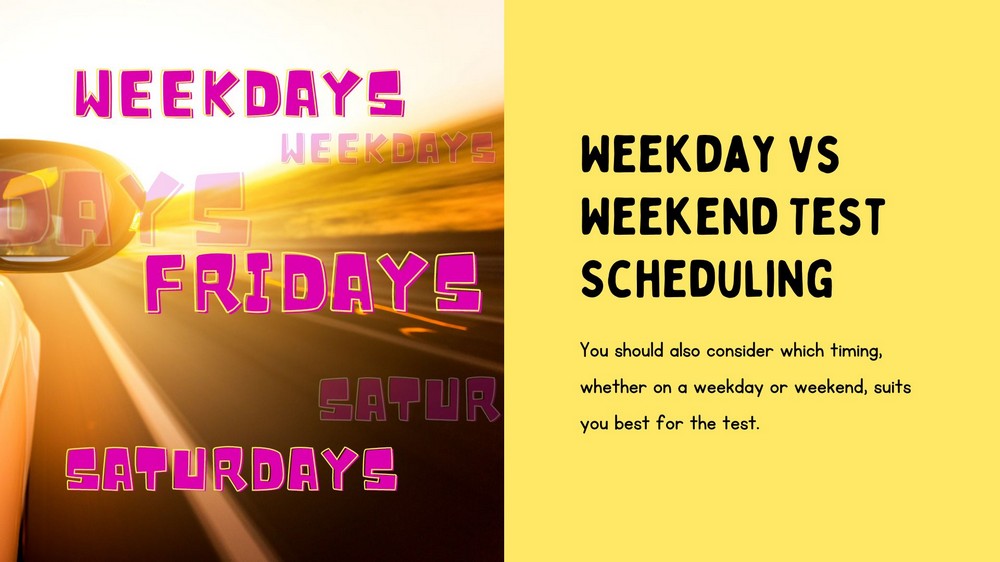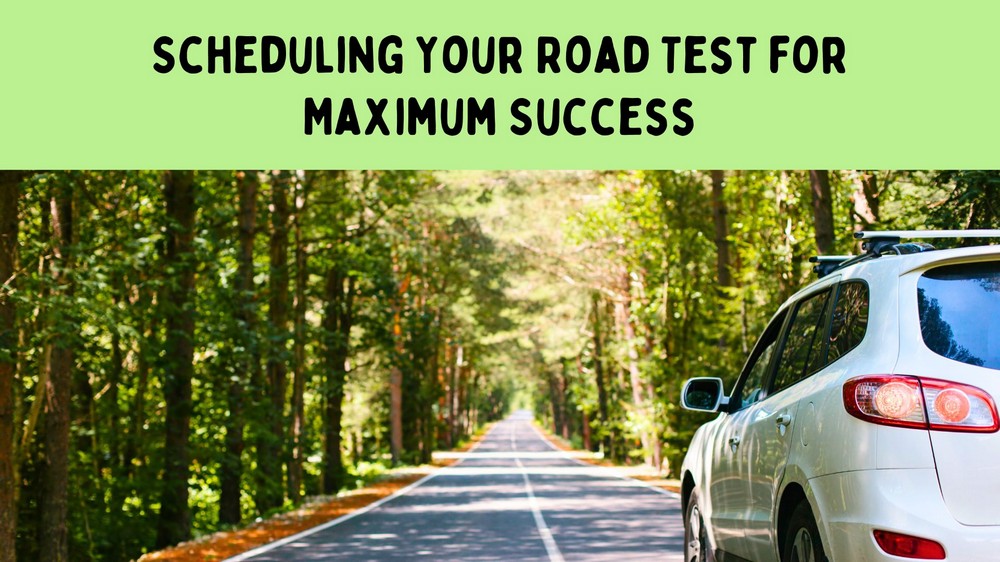What is the Best Time to Take Your Driver's Test in New York?

Table of Contents
Taking your driver's test can be a nerve-wracking experience. Choosing the right time to take your test is crucial for giving yourself the best chance to succeed. This article will guide you on selecting the optimal time slot and overall timing for your New York driver’s test.
Why Timing Matters
The time and day you schedule your driving test for can have a significant impact on:
- Traffic and congestion levels
- Weather and visibility
- Test availability and waiting times
- Your mental sharpness and physical comfort
Properly preparing for your driver's test involves careful consideration of all these factors. Failing to account for these elements can negatively impact your testing experience and results.
Key Factors Influencing Test Timing
There are a few key timing considerations that can influence your driver's test outcomes:
- Month - Spring and summer months see better weather but can also have heavier traffic. Autumn has moderate weather and congestion, while winter has light traffic but poor conditions.
- Day - Weekdays offer more test slots but heavier traffic, Fridays are lighter, and Saturdays have few slots but least traffic.
- Time - Mornings until noon offer gradually worsening conditions. Afternoons see bad traffic but allow test-day breaks.
- Location & Route - Research your local DMV traffic patterns.
- Readiness - Take your test only after thorough practice.
By weighing these elements intelligently, you can schedule your driving test during ideal conditions. The next sections will cover specific timing recommendations so you can register for your test with confidence.
Best Months for Taking Your Test
When choosing which month to take your driving test, you'll need to balance weather conditions, traffic patterns, and test availability.
Spring & Summer
The spring and summer months of April through August tend to have the highest passing rates due to favorable weather and lighting conditions. However, you may encounter heavier traffic volumes depending on the region and need to account for summer vacationers.
Autumn
Autumn offers pleasant temperatures and typically has lower congestion than the summer months. This makes September through November a solid option for taking your test. Just be mindful that daylight hours gradually become shorter as the season progresses.
Winter
November through March tends to have the lightest traffic due to inclement weather and the holiday season. However, you'll need to demonstrate competent driving abilities despite challenges like snow, sleet, and limited daylight. Also account for potential test cancellations due to extreme weather when scheduling for winter months.
Call Us Today 9AM-10PM
Or fill out the form 24/7
Our team is here to guide you with promotions, instructor availability, and the best training package for you.
Weekday vs Weekend Test Scheduling

You'll also need to decide whether a weekday or weekend test timing works better for you.
Weekdays
Monday through Thursday offers the maximum number of test appointments since DMV offices operate at full capacity on weekdays. However, you may encounter commuter traffic around rush hour periods.
Fridays
Test slots begin to fill up on Fridays compared to earlier weekdays. But the late-week timing also means lighter traffic, especially around midday.
Saturdays
Saturday tests are limited but offer the lightest traffic by avoiding typical commutes altogether. You’ll likely need to book well in advance to secure a Saturday slot.
Next Steps
With a better understanding of the seasonal, weekly, and daily factors that can impact your driver’s test, you can now use the next sections to zero in on more specific recommendations for acing your exam.
Best Time of Day for Taking Your Test
In addition to selecting the right day and month, choosing the optimal time of day for your driving test is key. Here are some guidelines on the best and worst times.
Early Morning (7 AM - 9 AM)
Scheduling your test for early morning offers some benefits:
- Less traffic congestion outside of rush hour
- Potentially better mental sharpness after a full night's rest
- Testing early gets it out of the way
However, early morning also brings some challenges:
- Rush hour may already be underway in some areas
- Reduced visibility from fog is more likely
- Traffic picks up sharply after 8 AM
If you can start right at 7 AM, early morning is a good option. But allow flexibility in case conditions are poor that day.
Mid-Morning (9 AM - 12 PM)
Mid-morning from 9 AM to noon is often considered the best window for taking your driver’s license test:
- Mostly avoids rush hour traffic
- Lower traffic than afternoon
- Full range of road types can be tested
- Reduced fatigue compared to later
Just be cautious of overlapping with school dismissal congestion around 10 AM to noon in urban locales.
Afternoon (12 PM - 4 PM)
Early afternoons have some advantages:
- Clears morning traffic snarls
- Allows mid-day breaks before testing
- May offer best visibility
However, afternoons also see challenges like:
- Traffic building up around rush hour
- Fatigue and lower alertness
- Limited route options if running short on time
Unless you have optimal local conditions, stick to morning test times when possible.
Call Us Today 9AM-10PM
Or fill out the form 24/7
Our team is here to guide you with promotions, instructor availability, and the best training package for you.
Scheduling Your Road Test for Maximum Success

As discussed throughout this article, selecting the right timing for your driver's license road test requires carefully weighing several factors that can impact your performance and outcomes on test day.
The optimal time to take your driving test will depend on the seasonal weather conditions, weekly and daily traffic patterns, DMV test availability, and your personal schedule and preferences. Striking the right balance between these elements is crucial.
Focus on choosing a test date and time slot that offers good visibility, minimal traffic, and peak mental sharpness for you. Schedule your test only once you've achieved adequate practice and preparation - don't rush into it.
With smart timing choices and thorough driving competence, you'll be equipped to excel on your Class D road test and get licensed with ease. Use this article's recommendations to make informed scheduling decisions and take to the streets with confidence.
Call Us Today 9AM-10PM
Or fill out the form 24/7
Our team is here to guide you with promotions, instructor availability, and the best training package for you.
Frequently Asked Questions
-
How far in advance should I book my driving test?
While waiting times vary, you should book your driving test at least several weeks out to secure your preferred time slot. Some busy DMV locations have longer booking backlogs, so check the official DMV website for the latest test availability.
-
Does the time of day affect my chances of passing?
Yes - the time of day you take your test can make it easier or harder to pass. The best times are early to mid-mornings, which offer lighter traffic and better alertness. Rush hour and school closing times should be avoided.
-
Does my driving test take place at night?
No, driving tests are generally not conducted after dark. However, be prepared for limited visibility during winter months when daylight hours are shorter. Know how to turn on headlights, use fog lights, manage visibility obstructions, etc.
-
When is the worst time to take the driving test?
The worst times to take your test are weekends, holidays that significantly increase traffic, and poor weather days with rain, snow or ice. Hazardous conditions often lead to test cancellations or failures.
-
Will I have a better chance of passing on certain weekdays?
While any weekday has potential for heavy traffic at rush hours, Fridays tend to be slightly better since commuter congestion starts decreasing headed into the weekend. Just know that Friday test appointments fill up faster.
-
Should I take a practice run of my test route?
Yes, it is highly recommended you drive the testing route with an instructor beforehand if possible. Familiarizing yourself with the driving environments and landmark cues will boost your confidence on exam day.
 English
English Spanish
Spanish 

